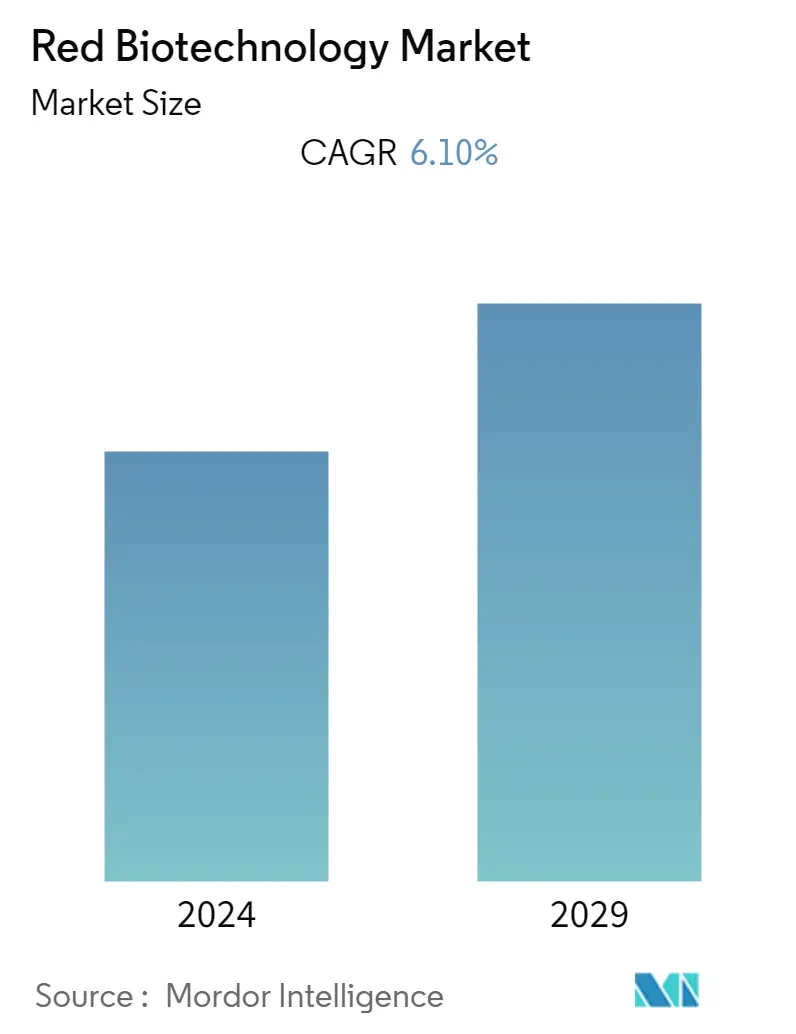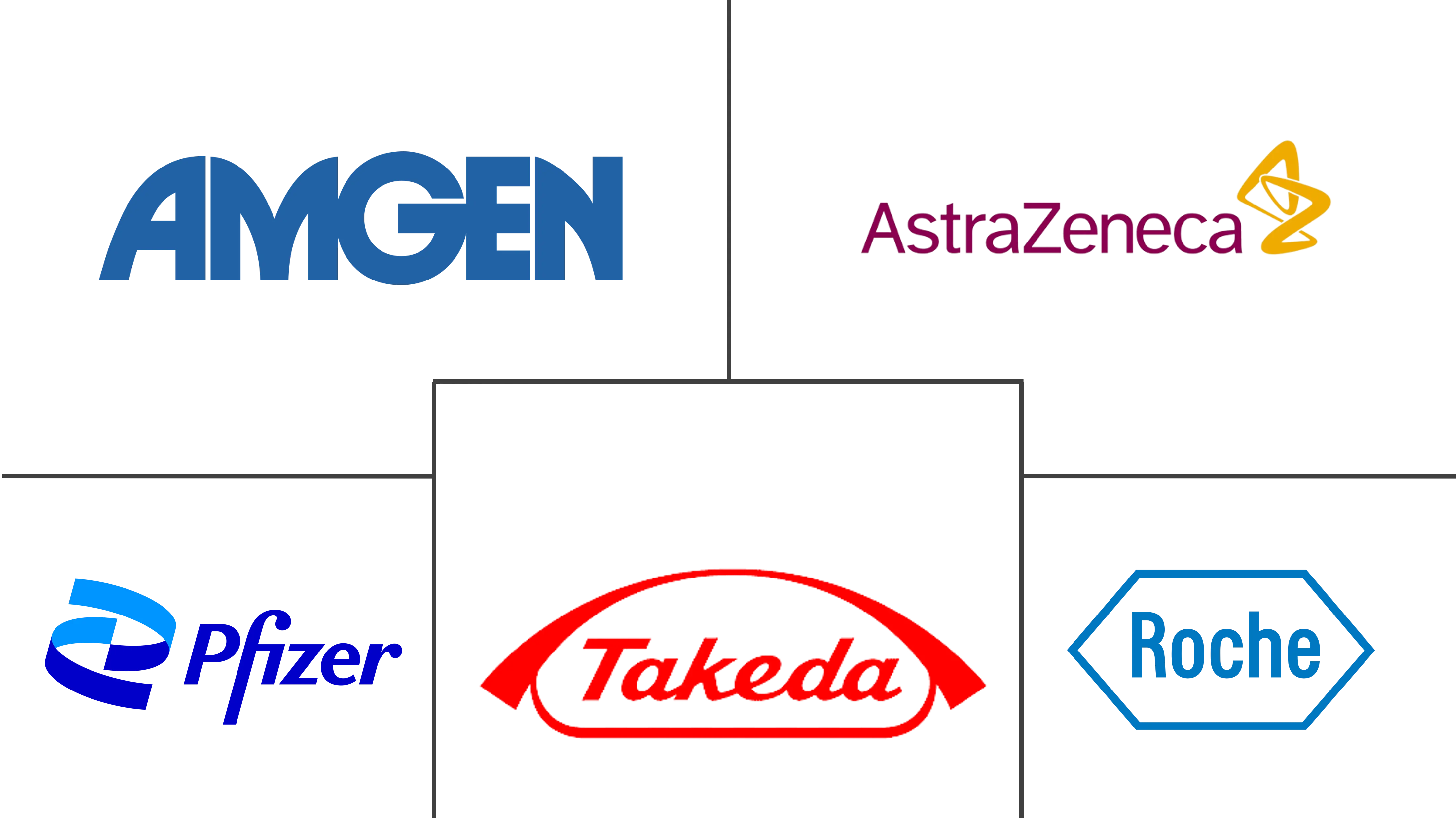Market Size of Red Biotechnology Industry

| Study Period | 2019 - 2029 |
| Base Year For Estimation | 2023 |
| Forecast Data Period | 2024 - 2029 |
| CAGR | 6.10 % |
| Fastest Growing Market | Asia Pacific |
| Largest Market | North America |
Major Players
*Disclaimer: Major Players sorted in no particular order |
Red Biotechnology Market Analysis
The red biotechnology market is expected to register a CAGR of 6.1% over the forecast period.
The COVID-19 pandemic had a significant impact on the red biotechnology sector globally. Red biotechnology is an important part of the fields of diagnostics, gene therapy, and clinical research and trials. It is used to manufacture vaccines, drugs, diagnostic reagents, cell lines, gene therapy products, and so on. Since biotechnology had a lot to provide for vaccine production, the pandemic significantly influenced the red biotechnology market since vaccine discovery and approvals were in high demand. For instance, according to the article published by the NCBI in March 2022, since the COVID-19 virus outbreak, several emerging biotechnologies and their multidisciplinary approaches accelerated the understanding of molecular details and the development of a wide range of diagnostics and potential vaccine candidates. Hence, COVID-19 had a positive impact on the studied market initially; however, as the pandemic has subsided, the red biotechnology market is expected to have favourable and stable growth during the forecast period of the study.
The factors driving the market growth include the rising incidence and prevalence of chronic and rare diseases and increased funding in the healthcare industry. For instance, according to the data released by the American Cancer Society (ACS) in January 2023, approximately 1,958,310 new cancer cases are projected to occur in the United States by the end of 2023. As per the same source, around 300,590 new breast cancer cases are predicted to happen in the United States in 2023. ACS also stated that over 18 million Americans were reported to have a history of cancer in the year 2022. In addition, the rising number of new cancer cases in various countries, including Australia, is also projected to burgeon market growth during the forecast period. For instance, according to the data released by the Australian Institute of Health and Welfare, in December 2022, approximately 62,000 new cancer cases were diagnosed in Australia in 2022. As per the same source, the most diagnosed cancers in males in the country were prostate cancer with 24,217 cases, melanoma with 10,374 cases, colorectal cancer with 8,300 cases and lung cancer with 7,707 cases. Therefore, the rising prevalence of cancer worldwide is projected to drive the demand for red biotechnology to boost the differential and early diagnosis of cancer, tumour progression control, and proper cancer treatment.
Moreover, increased funding by the government and prominent players in the biotechnology field has been driving market growth. For instance, in January 2022, Eli Lilly and Company signed a research and collaboration agreement with Entos Pharmaceuticals to develop innovative therapies in multiple neurologic indications, using Entos' Fusogenix nucleic acid delivery technology and Lilly's therapeutic cargo. Under the agreement, Eli Lilly and Company will fund USD 400 million for the developmental and commercialization of the nucleic acid-based therapeutic. Thus, with such investments and agreements, the R&D of red biotechnology will advance, which is set to drive market growth during the forecast period.
Thus, the rising prevalence of cancer and increasing funding by prominent players are likely to boost the growth of the red biotechnology market over the analysis period. However, the market's growth is set to be restrained by costly therapeutic technology and machinery.
Red Biotechnology Industry Segmentation
As per the scope of the report, red biotechnology is a process that utilizes organisms for the development and manufacturing of therapies and diagnostic techniques. The red biotechnology market is segmented by product (vaccines, drugs, and others), end user (biopharmaceutical companies, CMOs and CROs, and others), and geography (North America, Europe, Asia-Pacific, Middle East and Africa, and South America). The market report also covers the estimated market sizes and trends for 17 different countries across major regions globally. The report offers the value (in USD) for the above segments.
| By Product | |
| Vaccines | |
| Drugs | |
| Others |
| By End User | |
| Biopharmaceutical Companies | |
| CMOs and CROs | |
| Others |
| Geography | ||||||||
| ||||||||
| ||||||||
| ||||||||
| ||||||||
|
Red Biotechnology Market Size Summary
The red biotechnology market is poised for steady growth, driven by its critical role in diagnostics, gene therapy, and clinical research. The sector experienced an initial boost due to the COVID-19 pandemic, which heightened the demand for vaccine development and approvals, showcasing the potential of biotechnology in addressing global health challenges. As the pandemic's impact wanes, the market is expected to maintain favorable growth, supported by the increasing incidence of chronic and rare diseases and enhanced funding in the healthcare sector. The rising prevalence of cancer, in particular, is a significant factor propelling the demand for red biotechnology, as it aids in early diagnosis, tumor progression control, and effective treatment. Additionally, substantial investments by government and industry leaders in research and development are set to further advance the field, despite challenges posed by the high costs of therapeutic technologies.
The biopharmaceutical companies segment within the red biotechnology market is anticipated to experience significant expansion, fueled by ongoing research and development activities related to biopharmaceutical drugs. Notable advancements in medical biotechnology, such as FDA-approved gene-based therapies, underscore the sector's dynamic nature. North America holds a prominent position in the global market, attributed to its robust research and development activities, technological advancements, and a growing geriatric population. The competitive landscape is characterized by the presence of major players like Pfizer Inc., AstraZeneca PLC, and Amgen Inc., who are actively engaged in mergers and acquisitions to strengthen their market positions. Overall, the red biotechnology market is set to benefit from the convergence of increasing disease prevalence, technological innovations, and strategic investments, positioning it for sustained growth in the coming years.
Red Biotechnology Market Size - Table of Contents
-
1. MARKET DYNAMICS
-
1.1 Market Overview
-
1.2 Market Drivers
-
1.2.1 Rising Incidence and Prevalence of Chronic and Rare Diseases
-
1.2.2 Increased Funding in the Healthcare Industry
-
-
1.3 Market Restraints
-
1.3.1 Costly Therapeutic Technology and Machinery
-
-
1.4 Porter's Five Forces Analysis
-
1.4.1 Bargaining Power of Suppliers
-
1.4.2 Bargaining Power of Buyers/Consumers
-
1.4.3 Threat of New Entrants
-
1.4.4 Threat of Substitute Products
-
1.4.5 Intensity of Competitive Rivalry
-
-
-
2. MARKET SEGMENTATION (Market Size by Value - USD)
-
2.1 By Product
-
2.1.1 Vaccines
-
2.1.2 Drugs
-
2.1.3 Others
-
-
2.2 By End User
-
2.2.1 Biopharmaceutical Companies
-
2.2.2 CMOs and CROs
-
2.2.3 Others
-
-
2.3 Geography
-
2.3.1 North America
-
2.3.1.1 United States
-
2.3.1.2 Canada
-
2.3.1.3 Mexico
-
-
2.3.2 Europe
-
2.3.2.1 Germany
-
2.3.2.2 United Kingdom
-
2.3.2.3 France
-
2.3.2.4 Italy
-
2.3.2.5 Spain
-
2.3.2.6 Rest of Europe
-
-
2.3.3 Asia-Pacific
-
2.3.3.1 China
-
2.3.3.2 Japan
-
2.3.3.3 India
-
2.3.3.4 Australia
-
2.3.3.5 South Korea
-
2.3.3.6 Rest of Asia-Pacific
-
-
2.3.4 Middle East and Africa
-
2.3.4.1 GCC
-
2.3.4.2 South Africa
-
2.3.4.3 Rest of Middle East and Africa
-
-
2.3.5 South America
-
2.3.5.1 Brazil
-
2.3.5.2 Argentina
-
2.3.5.3 Rest of South America
-
-
-
Red Biotechnology Market Size FAQs
What is the current Global Red Biotechnology Market size?
The Global Red Biotechnology Market is projected to register a CAGR of 6.10% during the forecast period (2024-2029)
Who are the key players in Global Red Biotechnology Market?
Pfizer Inc, AstraZeneca Plc, F. Hoffmann-La Roche Ltd, Amgen Inc and Takeda Pharmaceutical Company Limited are the major companies operating in the Global Red Biotechnology Market.

